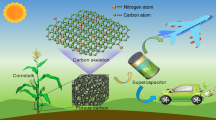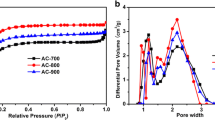Abstract
Creating energy storage devices from biomass waste has great scientific and industrial significance by providing an eco-friendly and sustainable alternative to reuse biowaste. This study demonstrates the production of high-performance supercapacitor electrodes using acai seed as a precursor for creating carbon materials. Porous carbons were synthesized by carbonization and subsequent KOH activation to generate microporosity then mesoporosity upon further activation. The materials displayed large specific surface areas and total pore volumes, with tunable pore structures depending on the degree of activation. The biomass-derived electrodes exhibited high specific capacitances of 346 F g−1 at 1 mA cm−2 and good electrochemical stability in which 88% of the initial capacitance was retained after 5000 charges/discharges cycles at 7 mA cm−2 in 1 M KOH electrolyte. These results place these materials among the best biomass-derived supercapacitors reported thus far. This study provides a great alternative for the management of the large-scale biowaste, acai seed.







Similar content being viewed by others
References
J. Li, K. Han, J. Qi, Z. Teng, M. Li, M. Wang, Biomass-derived 3D hierarchical porous carbon by two-step activation method for supercapacitor. J. Mater. Sci. 30, 19415–19425 (2019)
M. Sevilla, N. Diez, G.A. Ferrero, A.B. Fuertes, Sustainable supercapacitor electrodes produced by the activation of biomass with sodium thiosulfate. Energy Storage Mater. 18, 356–365 (2019)
W. Shi, B. Chang, H. Yin, S. Zhang, B. Yang, X. Dong, Crab shell-derived honeycomb-like graphitized hierarchically porous carbons for satisfactory rate performance of all-solid-state supercapacitors. Sustain. Energy Fuels 3, 1201–1214 (2019)
H. Yang, S. Ye, J. Zhou, T. Liang, Biomass-derived porous carbon materials for supercapacitor. Front. Chem. 7, 274–291 (2019)
Z. Bi, Q. Kong, Y. Cao, G. Sun, F. Su, X. Wei, X. Li, A. Ahmad, L. Xie, C.-M. Chen, Biomass-derived porous carbon materials with different dimensions for supercapacitor electrodes: a review. J. Mater. Chem. A 7, 16028–16045 (2019)
E.D. Ángel-Meraz, H.J. Orantes-Flores, E.R. Morales, P.Y. Sevilla-Camacho, R. Castillo-Palomera, The use of activated carbon from cofee endocarp for the manufacture of supercapacitors. J. Mater. Sci. 31, 7547–7554 (2020)
J. Xu, Q. Gao, Y. Zhang, Y. Tan, W. Tian, L. Zhu, L. Jiang, Preparing two-dimensional microporous carbon from pistachio nutshell with high areal capacitance as supercapacitor materials. Sci. Rep. 4, 5540–5551 (2015)
H. Ma, Z. Chen, X. Wang, Z. Liu, X. Liu, A simple route for hierarchically porous carbon derived from corn straw for supercapacitor application. J. Renew. Sustain. Energy 11, 24102–24106 (2019)
J. Xu, N. Yuan, J.M. Razal, Y. Zheng, X. Zhou, J. Ding, K. Cho, S. Ge, R. Zhang, Y. Gogotsi, R.H. Baughman, Temperature-independent capacitance of carbon-based supercapacitor from −100 to 60 °C. Energy Storage Mater. 22, 323–329 (2019)
S. Ahmed, M. Rafat, A. Ahmed, Nitrogen doped activated carbon derived from orange peel for supercapacitor application. Adv. Nat. Sci. Nanosci. Nanotechnol. 9, 35008–35016 (2018)
Q. Wang, M. Zhou, Y. Zhang, M. Liu, W. Xiong, S. Liu, Large surface area porous carbon materials synthesized by direct carbonization of banana peel and citrate salts for use as high-performance supercapacitors. J. Mater. Sci. 29, 4294–4300 (2018)
P. Yu, Y. Liang, H. Dong, H. Hu, S. Liu, L. Peng, M. Zheng, Y. Xiao, Y. Liu, Rational synthesis of highly porous carbon from waste bagasse for advanced supercapacitor application. ACS Sustain. Chem. Eng. 6, 5325–15332 (2018)
X. Qu, Y. Liu, C. Zhang, A. Zhu, T. Wang, Y. Tian, J. Yu, B. Xing, G. Huang, Y. Cao, Effect of different pretreatment methods on sesame husk-based activated carbon for supercapacitors with aqueous and organic electrolytes. J. Mater. Sci. 30, 7873–7882 (2019)
K.M. Vighnesha, A. Shruthi, N. Sandhya, D.N. Sangeetha, M. Selvakumar, Synthesis and characterization of activated carbon/conducting polymer composite electrode for supercapacitor applications. J. Mater. Sci. 29, 914–921 (2018)
J.S. Reis, R.O. Araujo, V.M.R. Lima, L.S. Queiroz, C.E.F. da Costa, J.J.R. Pardauil, J.S. Chaar, G.N. Rocha Filho, L.K.C. Souza, Combustion properties of potential Amazon biomass waste for use as fuel. J. Therm. Anal. Calorim. 138, 3535–3539 (2019)
S. Lv, L. Ma, Q. Zhou, X. Shen, H. Tong, Three-dimensional self-doped hierarchical porous mussel nacre-derived carbons for high performance supercapacitors. J. Mater. Sci. 30, 14382–14390 (2019)
L. Borchardt, D. Leistenschneider, J. Haase, M. Dvoyashkin, Revising the concept of pore hierarchy for ionic transport in carbon materials for supercapacitors. Adv. Energy Mater. 8(24), 1–8 (2018)
G. Huang, Q. Geng, W. Kang, Y. Liu, Y. Li, B. Xing, Q. Liu, C. Zhang, Hierarchical porous carbon with optimized mesopore structure and nitrogen doping for supercapacitor electrodes. Microporous Mesoporous Mater. 288, 109576 (2019)
Y. Wen, L. Zhang, J. Liu, X. Wen, X. Chen, J. Ma, T. Tang, E. Mijowska, Hierarchical porous carbon sheets derived on a MgO template for high-performance supercapacitor applications. Nanotechnology 30(29), 295703–295713 (2019)
A.S. Ello, L.K.C. Souza, A. Trokourey, M. Jaroniec, Coconut shell-based microporous carbons for CO2 capture. Microporous Mesoporous Mater. 180, 280–283 (2013)
A.S. Ello, L.K.C. Souza, A. Trokourey, M. Jaroniec, Development of microporous carbons for CO2 capture by KOH activation of African palm shells. J. CO2 Util. 2, 35–38 (2013)
L.K.C. Souza, N.P. Wickramaratne, A.S. Ello, M.J.F. da Costa, C.E.F. Costa, M. Jaroniec, Enhancement of CO2 adsorption on phenolic resin-based mesoporous carbons by KOH activation. Carbon 65, 334–340 (2013)
L.K.C. Souza, A.A.S. Gonçalves, L.S. Queiroz, J.S. Chaar, G.N. da Rocha Filho, C.E.F. da Costa, Utilization of acai stone biomass for the sustainable production of nanoporous carbon for CO2 capture. Sustain. Mater. Technol. 25, e00168 (2020)
R.O. Araujo, J.S. Chaar, L.S. Queiroz, G.N. Rocha Filho, C.E.F. da Costa, G.C.T. Silva, R. Landers, M.J.F. Costa, A.A.S. Gonçalves, L.K.C. Souza, Low temperature sulfonation of acai stone biomass derived carbons as acid catalysts for esterification reactions. Energy Conv. Manag. 196, 821–830 (2019)
Foundation of the Brazilian Institute for Geography and Statistics (IBGE), https://sidra.ibge.gov.br/tabela/289#resultado, Accessed April 2020.
S. Brunauer, P.H. Emmett, E. Teller, Adsorption of gases in multimolecular layers. J. Am. Chem. Soc. 60(2), 309–319 (1938)
M. Kruk, M. Jaroniec, Gas adsorption characterization of ordered organic−inorganic nanocomposite materials. Chem. Mater. 13(10), 3169–3183 (2001)
G. Du, Q. Bian, J. Zhang, X. Yang, Facile fabrication of hierarchical porous carbon for a high-performance electrochemical capacitor. RSC Adv. 7, 46329–46335 (2017)
Z.-Q. Hao, J.-P. Cao, Y. Wu, X.-Y. Zhao, Q.-Q. Zhuang, X.-Y. Wang, X.-Y. Wei, Preparation of porous carbon sphere from waste sugar solution for electric double-layer capacitor. J. Power Sources 361, 249–258 (2017)
P.L. Taberna, P. Simon, J.F. Fauvarque, Electrochemical characteristics and impedance spectroscopy studies of carbon-carbon supercapacitors. J. Electrochem. Soc. 150(3), 292–300 (2003)
H. Randriamahazaka, K. Asaka, Electromechanical analysis by means of complex capacitance of bucky-gel actuators based on single-walled carbon nanotubes and an ionic liquid. J. Phys. Chem. C 114(41), 17982–17988 (2010)
A. Singh, A. Chandra, Significant performance enhancement in asymmetric supercapacitors based on metal oxides, carbon nanotubes and neutral aqueous electrolyte. Sci. Rep. 5, 1–12 (2015)
J. Cheng, Q. Xu, X. Wang, Z. Li, F. Wu, J. Shao, H. Xie, Ultrahigh-surface-area nitrogen-doped hierarchically porous carbon materials derived from chitosan and betaine hydrochloride sustainable precursors for high-performance supercapacitors. Sustain. Energy Fuels 3, 1215–1224 (2019)
I.I. Misnon, N.K.M. Zain, T.S. Lei, B.L. Vijayan, R. Jose, Activated carbon with graphitic content from stinky bean seedpod biowaste as supercapacitive electrode material. Ionics (2020). https://doi.org/10.1007/s11581-020-03565-x
L. Hu, J. Hou, Y. Ma, H. Li, T. Zhaia, Multi-heteroatom self-doped porous carbon derived from swim bladders for large capacitance supercapacitors. J. Mater. Chem. A 4, 15006–15014 (2016)
M. Thommes, K. Kaneko, A.V. Neimark, J.P. Olivier, F. Rodriguez-Reinoso, J. Rouquerol, K.S.W. Sing, Physisorption of gases, with special reference to the evaluation of surface area and pore size distribution (IUPAC Technical Report). Pure Appl. Chem. 87, 1051–1069 (2015)
J. Jagiello, J.P. Oliver, 2D-NLDFT adsorption models for carbon slit-shaped pores with surface energetical heterogeneity and geometrical corrugation. Carbon 55, 70–80 (2013)
C. Liu, W. Chen, S. Hong, M. Pan, M. Jiang, Q. Wu, C. Mei, fast microwave synthesis of hierarchical porous carbons from waste palm boosted by activated carbons for supercapacitors. Nanomaterials 9(3), 405–408 (2019)
H. Itoi, H. Nishihara, T. Kyotani, Effect of heteroatoms in ordered microporous carbons on their electrochemical capacitance. Langmuir 32(46), 11997–12004 (2016)
Y.S. Yun, M.H. Park, S.J. Hong, M.E. Lee, Y.W. Park, H.-J. Jin, Hierarchically porous carbon nanosheets from waste coffee grounds for supercapacitors. ACS Appl. Mater. Interfaces 7(6), 3684–3690 (2015)
H. Yoon, H.-J. Kim, J.J. Yoo, C.-Y. Yoo, J.H. Park, Y.A. Lee, W.K. Cho, Y.-K. Han, D.H. Kim, Pseudocapacitive slurry electrodes using redox-active quinone for high-performance flow capacitors: an atomic-level understanding of pore texture and capacitance enhancement. J. Mater. Chem. A 3, 23323–23332 (2015)
J. Lee, Y.A. Lee, C.-Y. Yoo, J.J. Yoo, R. Gwak, W.K. Cho, B. Kim, H. Yoon, Self-templated synthesis of interconnected porous carbon nanosheets with controllable pore size: Mechanism and electrochemical capacitor application. Microporous Mesoporous Mater. 261, 119–125 (2017)
J. Chen, X. Zhou, C. Mei, J. Xu, S. Zhou, C.-P. Wong, Evaluating biomass-derived hierarchically porous carbon as the positive electrode material for hybrid Na-ion capacitors. J. Power Sources 342, 48–55 (2017)
W. Xing, C.C. Huang, S.P. Zhuo, X. Yuan, G.Q. Wang, D. Hulicova-Jurcakov, Z.F. Yan, G.Q. Lu, Hierarchical porous carbons with high performance for supercapacitor electrodes. Carbon 47(7), 1715–1722 (2009)
X. Jiang, M. Huang, X. Ju, X. Meng, Fabrication of hierarchical porous carbon spheres for electrochemical capacitor application. Chem. Lett. 45, 48–50 (2016)
L. Qiang, Z. Hu, Z. Li, Y. Yang, X. Wang, Y. Zhou, X. Zhang, W. Wang, Q. Wang, Hierarchical porous biomass carbon derived from cypress coats for high energy supercapacitors. J. Mater. Sci. 30, 7324–7636 (2019)
Y. Sun, J. Xue, S. Dong, Y. Zhang, Y. An, B. Ding, T. Zhang, H. Dou, X. Zhang, Biomass-derived porous carbon electrodes for high-performance supercapacitors. J. Mater. Sci. 55, 5166–5176 (2020)
Y. Shu, A. Dobashi, C. Li, Y. Shen, H. Uyama, Hierarchical porous carbon from greening plant shell for electric double-layer capacitor application. Bull. Chem. Soc. Jpn. 90, 44–51 (2016)
J. Gamby, P.L. Taberna, P. Simon, J.F. Fauvarque, M. Chesneau, Studies and characterisations of various activated carbons used for carbon/carbon supercapacitors. J. Power Sources 101(1), 109–119 (2001)
J. Yan, T. Wei, W. Qiao, B. Shao, Q. Zhao, L. Zhang, Z. Fan, Rapid microwave-assisted synthesis of graphene nanosheet/Co3O4 composite for supercapacitors. Electrochim. Acta. 55(23), 6973–6978 (2010)
C. Yang, C.-Y.V. Li, F. Li, K.-Y. Chan, Complex impedance with transmission line model and complex capacitance analysis of ion transport and accumulation in hierarchical core-shell porous carbons. J. Electrochem. Soci. 160(4), 271–278 (2013)
X. Yang, G. Du, L. Zhang, Y. Liu, Preparation of hierarchical porous carbon material derived from starch for high-performance electrochemical capacitor. Mater. Lett. 183, 52–55 (2016)
A. Oz, S. Hershkovitz, N. Belman, E. Tal-Gutelmacher, Y. Tsur, Analysis of impedance spectroscopy of aqueous supercapacitors by evolutionary programming: finding DFRT from complex capacitance. Solid State Ion. 288, 311–314 (2016)
V. Ganesh, S. Pitchumani, V. Lakshminarayanan, New symmetric and asymmetric supercapacitors based on high surface area porous nickel and activated carbon. J. Power Sources 158(2), 1523–1532 (2006)
P. Navalpotro, M. Anderson, R. Marcilla, J. Palma, Insights into the energy storage mechanism of hybrid supercapacitors with redox electrolytes by electrochemical impedance spectroscopy. Electrochim. Acta 263, 110–117 (2018)
C. Lei, F. Markoulidis, Z. Ashitaka, C. Lekakou, Reduction of porous carbon/Al contact resistance for an electric double-layer capacitor (EDLC). Electrochim. Acta. 92, 183–187 (2013)
Acknowledgements
This work was financially supported by the UFAM multidisciplinary program and FAPEAM; granted by the National Council for Scientific and Technological Development (CNPq). MJFC and DVS would like to thank the São Paulo Research Foundation (FAPESP) for Grants Nos 2016/14165-0, 2016/15962-0, and 2013/07793-.
Author information
Authors and Affiliations
Corresponding author
Additional information
Publisher's Note
Springer Nature remains neutral with regard to jurisdictional claims in published maps and institutional affiliations.
Rights and permissions
About this article
Cite this article
de Souza, L.K.C., Martins, J.C., Oliveira, D.P. et al. Hierarchical porous carbon derived from acai seed biowaste for supercapacitor electrode materials. J Mater Sci: Mater Electron 31, 12148–12157 (2020). https://doi.org/10.1007/s10854-020-03761-5
Received:
Accepted:
Published:
Issue Date:
DOI: https://doi.org/10.1007/s10854-020-03761-5




